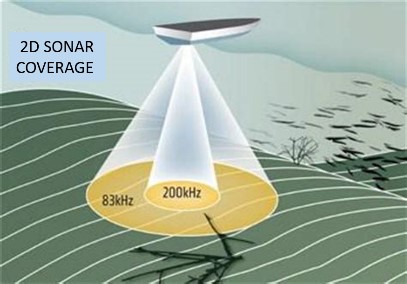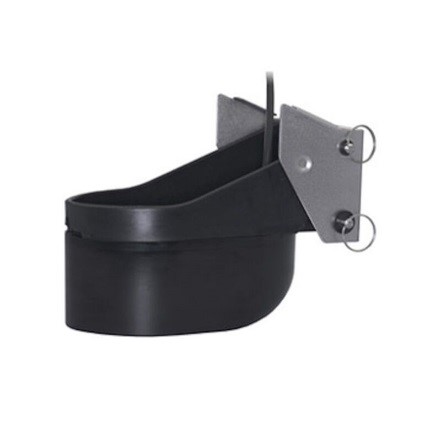Sonar Coverage Area
We all wish we had “eyes” under the water, but right now sonar will have to do. Most anglers have at least one sonar unit on their boat with traditional 2D sonar, but most don’t know how much area they are looking at below their boat and how they can change how much they are viewing. Captain Lance reviews 2D sonar coverage area, how big it is and how and angler can change it.
2D Sonar Coverage Area
Have you ever caught a fish when there were none on your sonar screen? Have you ever had a screen full of fish but couldn’t get a bite? Well, it may not have been good or bad luck, it may have been due to a lack of understanding the actual coverage area of your sonar unit’s transducer.
 Let’s start with some basics about 2D sonar coverage. First, the “ping” from your transducer travels through the water in basically a cone shape, with the pointed end at the transducer and the cone getting wider as the water gets deeper. From the top that cone is basically a circle, again getting wider as the water gets deeper. But how wide is that circle?
Let’s start with some basics about 2D sonar coverage. First, the “ping” from your transducer travels through the water in basically a cone shape, with the pointed end at the transducer and the cone getting wider as the water gets deeper. From the top that cone is basically a circle, again getting wider as the water gets deeper. But how wide is that circle?
Let’s start with a basic 200 kHz transducer with a 20-degree cone, probably the most popular configuration in fresh water fishing. With this setup the coverage area of the circle is only about 1/3 the depth of the water! That’s right; in 30 feet of water the cone only has a diameter of 10’! Now think a little bit more. The transducer is right in the middle of that 10’ circle, meaning your cone is only 5’ from the transducer in any direction; that is NOT a big area.
So, you may be catching fish with a “blank” screen if they are just outside the coverage area, and you may have a screen full of fish but your lures off to the side of the boat are too far away from them to chase!
Traditional 2D sonar is valuable and necessary since it marks bottom and fish at high speeds, shows us fish “arches”, can identify relative size of fish by using different colors and gives us a pretty accurate idea of the depth of a fish. So, how can we expand our coverage area to take advantage of these characteristics and see more area? First, we can change the frequency we are using. Most standard transducers work on both the 200 kHz frequency we talked about and 83 kHz. The 83 kHz frequency is a great compromise since it widens the cone (coverage area is about 60% of the water depth, so 18’ in diameter in 30 feet of water) but it still gives us the target identification and separation that we get with 200 kHz. Using a Medium CHIRP setting (if available) will do the same thing on most units.
 Second, we can increase the power of our transducer. By upgrading to a high-performance transducer, like a B66 or the TM165 or TM185, the power transmitted increases even though the cone angle stays about the same. Sending more power into the water means the “ping” will travel further outside of the traditional cone shape and look at a bigger area. For anyone looking for better sonar performance, more coverage area and better target separation this would be my first recommendation.
Second, we can increase the power of our transducer. By upgrading to a high-performance transducer, like a B66 or the TM165 or TM185, the power transmitted increases even though the cone angle stays about the same. Sending more power into the water means the “ping” will travel further outside of the traditional cone shape and look at a bigger area. For anyone looking for better sonar performance, more coverage area and better target separation this would be my first recommendation.
Third, we can increase the Sensitivity, or Gain, setting on our unit. By turning the gain up, we will get a little more interference on the screen but that will result in “seeing” a wider coverage area, since less intense targets will still show up on our screen.
Even with any of the above changes to widen our coverage area, we are still limited into where and what we can see on 2D sonar. While 2D sonar is necessary and is great at what it does, to see the whole picture an angler needs to consider adding DownScan, SideScan and even Live sonar…they all do something different and work best together!

